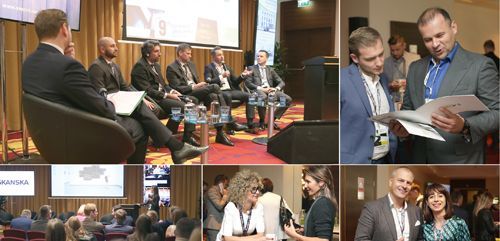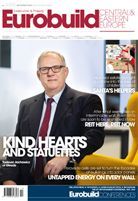The office express that will not run out of steam
Events
The conference opened with a presentation devoted to the new trend of biophilic office design – which was given by Halina Kamińska, the CEO of Florabo. “With the latest technology and cultivation techniques, our offices can now be made to resemble lush gardens filled with plants, but in such a way that they don’t clutter up the space and make it a less efficient space to work in,” she claimed.
The first discussion panel, which was moderated by Mikołaj Sznajder, the head of the office advisory and transaction services at CBRE in Warsaw, was looked at Poland’s regional office markets. “Entering large provincial cities in Poland is easier than, for example, debuting on such regional markets in France. The big secondary Polish cities are now mature, dynamic markets that provide many investment possibilities, whereas the French market remains strongly centralised,” claimed Matthias Brodesser, the head of international transaction management at Warburg-HIH Invest Real Estate. “Regional markets in Poland are attractive to investors because they are not as susceptible to changes in the business cycle as Warsaw is. To see this we just have to look at the swings in rent levels: in Warsaw they recently ranged widely between EUR 20 and EUR 30 for class ‘A’ buildings, whereas in the regions, with rates of around a dozen euros, the difference was only EUR 1–2 over the same period,” pointed out Adrian Karczewicz, the head of divestment of Skanska’s CEE commercial development unit.
Another feature of this year’s event was the first sparring session at a Eurobuild conference –and the inaugural one pitted a landlord against a tenant. Locking horns were Michał Jeziorski, the CEO of entrepreneurial development foundation TwójStartUp, and Eyal Litvin, the managing director of Adgar Poland. Each adversary in turn came up with contentious issues that the other had to respond to. They tussled over the first topic (What are eco-certificates for and who actually bears their costs?), but the differences in approach to the roles played by investors and tenants were even more evident when it came to the next issue on the agenda: “Why are building owners so reluctant to put tenants’ logos on their buildings? It would be ideal for raising their profiles,” pointed out Michał Jeziorski. “I can assure you that these signs quickly merge into the cityscape and no one sees them after that – except maybe the owners themselves,” riposted Eyal Litvin. “Where did this trend for closing down office canteens come from? We work a dozen hours a day and we don’t have time to look for a free table for lunch all over the district,” protested the CEO of TwójStartUp. “We closed the canteens in all our buildings and it was a very good decision. The smells coming from the kitchens don’t actually add to the prestige of a property – and it’s no longer necessary to have food prepared in situ in an age when you can order any dish you like to be delivered,” the general manager of Adgar countered. Happily, The discussion ended without blood being spilled, as both combatants finally agreed that cooperation between the owner and the tenant is indispensable and so compromises are sometimes required, thus bringing the sparring to an end with a draw agreed.
The crucial thing for modern skyscrapers is that they have to be friendly and multifunctional – agreed the members of the next panel, this time moderated by Krzysztof Misiak of Cushman & Wakefield. They mostly discussed the role that such office towers now play on the market. “A skyscraper makes sense if its construction is economically justified. The prestige by itself is not be enough to lease it – the market for those tenants who care greatly about the prestige of being established in a glass tower is actually very limited,” pointed out Szymon Wojciechowski of the APA Wojciechowski studio. “Skyscrapers must now become democratising elements of the cityscape – the rents are now more and more affordable, public areas are being developed near the buildings, and the practical aspects such as having good transport links and easy access to employees, count for more than the exclusivity,” added Jarosław Prawicki of Karimpol Polska.
After the break, the second section of the conference got underway with the power speech by Antony Slumbers, who gave a fascinating presentation on the causes and effects of proptech – technological innovations in the real estate sector. It may now be possible to replace the work of a significant number of professions with modern technological systems, but it’s unlikely that artificial intelligence will ever replace people completely in our sector – which should be a relief for anyone reading this (unless you’re a robot, of course).
When can we expect to see investment deals on the office market with yields of less than 4.5 pct? What impressions did you take away from Expo Real? What currency do you keep your savings in? – these were some of the questions put to the special guest of the Conference, Tomasz Buras, the managing director of Savills, in a new, experimental section in which the audience asked all the questions. The questions could be posed using the Match Maker app, or written on cards cards dropped into a container, or even asked directly. Along with some rather formal topics (What’s the future for co-working in Poland? Will the ever higher construction costs lead to higher office rents? What kind of people do you employ in Savills’ office department?), Tomasz Buras was also surprised by some of a lighter vein, as a result of which it was revealed that the Savills boss keeps his savings in the form of real estate, and that he has never been stuck in the lift of the Q22 building, where Savills’ headquarters are located – even though after the lift door closes, you sometimes have to wait for the elevator above it to start its journey. “This is tolerable as long as the re’s good company in the lift,” he insisted.
The next panel, moderated by Dorota Osiecka of Colliers International, examined how office interiors should be laid out for the needs of several generations of employees at one time. “It is impossible to design offices that stay at the cutting edge for many years, and – to be honest – we’re not particularly interested in doing so,” was the rather tongue-in-cheek consensus of the panellists. An office building has a lifecycle of several years, after which it’s necessary to at least thoroughly refurbish its interiors to keep up with the latest trends, customer requirements and technological systems. “Clients are demanding today, so we have to design what we offer for their needs. The enquiries that we receive from potential clients often include detailed questions about the standard of the building and its equipment. The record so far was one that went to 900 pages, which took us a few days to prepare the answers for,” commented Monika Rogucka of Cavatina.
After lunch it was time for the workshop section of the conference. This involved two seminars, the first of which, led by held by Business Link, looked at analysing the needs of co-working companies (this was broadcast live on our Eurobuild TV YouTube channel). The other workshop, on trends in office design, was led by Bartosz Trzop of the Trzop Architekci studio. Both of the workshops were completely packed out.
We would like to thank all those who attended the conference, the speakers and panellists, as well as our sponsors: Business Link, Cavatina, Vastint, Skanska, Poleczki Park, HR Design Group, Spaceplan, Archicom, Trzop Architekci, S-Bridge Office and Bene. ν





















































